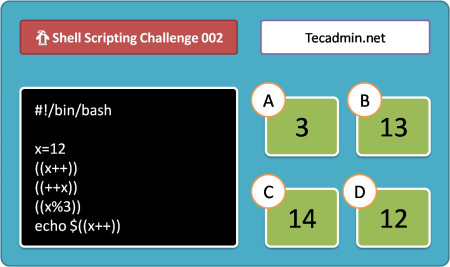Welcome to our Shell Scripting Challenge! Today, we have an engaging script designed to test your understanding of some fundamental concepts in shell scripting, particularly focusing on variable scope and function behavior. Examine the script below, try running it on your own, and then explore the explanation to enhance your knowledge of how shell scripts operate.
The Shell Script
#!/bin/bash
function mystery() {
local x=2
echo $((x+2))
}
x=1
echo $(mystery $x)
Challenge
Take a moment to predict what you think the output of this script will be when executed in a Bash shell. Writing down your guesses can help you compare and learn better when you review the explanation.
Script Explanation
Let’s analyze the script part by part:
Shebang Line
#!/bin/bash
This line specifies that the script should be executed using Bash, the Bourne Again SHell, ensuring that it runs with the intended shell environment.
Function Definition: mystery
function mystery() {
local x=2
echo $((x+2))
}
- Function Declaration: This begins with function
mystery(), defining a new function named mystery. - Local Variable Declaration: Within the function,
local x=2declares a local variable x. The local keyword confines the variable’s scope strictly to the function, so it does not interfere with any variables outside its scope. - Arithmetic and Echo: The command
echo $((x+2))calculates the sum of x and 2, where x is 2, thus resulting in 4. This value is then output by the echo command.
Main Script Body
x=1
echo $(mystery $x)
- Global Variable Declaration:
x=1sets a global variable x with a value of 1. - Function Call with Echo:
echo $(mystery $x)calls the mystery function. Although$xis passed to the function, it is not utilized inside the function because mystery does not use parameters, and it has its ownlocal x. The result of the function, which is 4, is captured by$(...)(command substitution) and then printed.
Expected Output
When the script is executed, the output will be:
4
This output comes from the function mystery, which calculates 4 as discussed, and the echo statement prints this value. The script only outputs this single line because that’s the only echo command outside of the function that produces visible output.
Conclusion
This challenge highlights the importance of understanding variable scope in shell scripts. The local variable inside the function does not affect the global variable, demonstrating how encapsulation works within functions in Bash. By grasping these concepts, scriptwriters can avoid common pitfalls and ensure their scripts perform as expected.
Experiment with variations of this script to see how different modifications can influence the behavior and output. Continue challenging yourself with these exercises to build a robust understanding of shell scripting. Stay tuned for more challenges!
